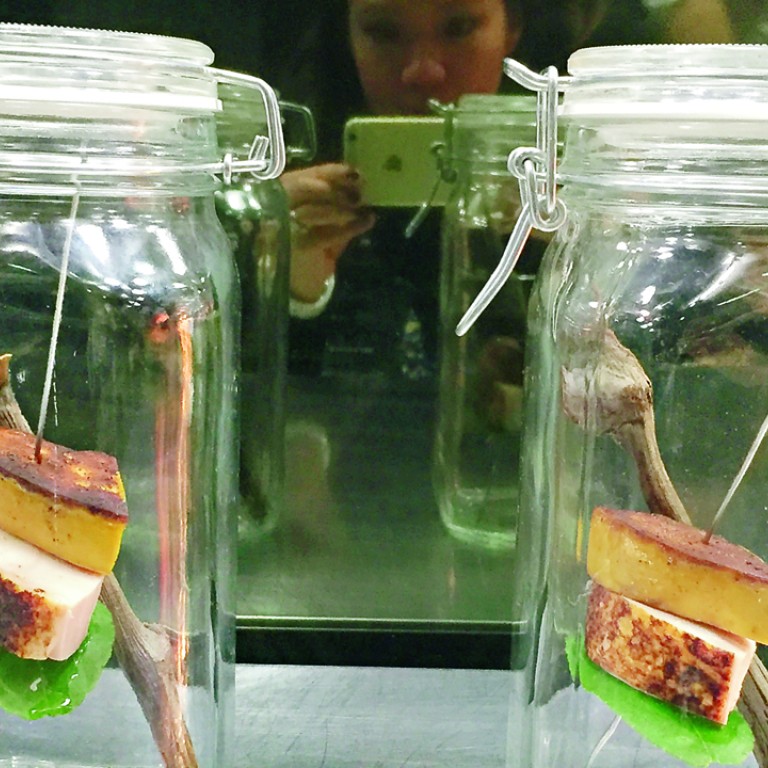
Dinner as theatre: behind the scenes at Ultraviolet, Shanghai ‘immersive’ restaurant
The ‘actors’ - Paul Pairet’s chefs and servers – present 20-course French menu to their ‘audience’: one table of guests amid a vast room who are fed sounds, smells, images and incident along with the dishes. Kitchen team get a voyeuristic thrill as they watch CCTV cameras convey the diners’ reactions
Having to stay in the kitchen of Ultraviolet in Shanghai while chef Paul Pairet and his team cook for a table full of guests – all chefs who have between them a total of 25 Michelin stars – might make it seem like I’ve been relegated to second class status. But I’m philosophical about it; after all, anyone who plans far enough in advance can book a place at the 10-seat “immersive dining” restaurant, but not everyone gets to witness what goes on behind the scenes.
The 10 guests have met in advance before being driven to Ultraviolet, which is in an undisclosed location. Head chef Greg Robinson gets a phone call, alerting him that the guests are en route – timing is key here – and the kitchen moves into action.
I am already at the grungy warehouse creative space with Pairet. The size of Ultraviolet is about the equivalent of a football field, and would seat about 100 if it were a “normal” restaurant. Pairet’s vision is different, though: his place only seats only 10.

It’s fascinating to observe the Ultraviolet chefs cooking with absolute precision while watching the guest’s reactions to the food and the multisensory experience in the dining room as seen through CCTV cameras. The servers pick up the dishes according to cues and tempo – exactly how a theatre production is run.
It goes like clockwork, with timing and temperatures planned right down to the decimal point. The kitchen is silent, apart from the occasional beeping equipment and a call-out for the next scene and next dishes.


In addition to running the kitchen team, led by Robinson, Pairet takes on the role of director – managing the production team who bring together the different elements, including sound, lights, set and design, to trigger memories, raise questions and take diners out of their comfort zone.

The 20-course meal with wine pairings is accompanied by audio, visual and olfactory stimulants. Pairet works from a media library, which sounds like how an ad agency would run, with producers having endless materials to source. Pairet, however, works the other way around. “The food always leads,” he says. The scenarios and creative conceptualisation follow.”
Robinson works with three sous chefs and the team to perfect every menu. “The first menu we launched in 2012 took 10 full rehearsals. We currently have two menus: UV A and UV B, and the menus are updated every year, with UV C set to launch in May 2016.”
Developing a new menu takes up about 75 per cent of Pairet’s time and scenarios are sketched out by him as the menu [evolves].

Robinson explains: “The technique is very similar to sous vide – vacuumed air-tight, flavoured slowly by five spices and cooking the fish in liquid gel. The gel cools and when we unmould it, we reveal a perfectly cooked fish.”
The idea of Ultraviolet was conceived nearly 20 years ago and finally came to life in Shanghai in 2012; it was a huge project, given the logistics and cost challenges.
As always, a brilliant idea is often “adapted” by others. Paco Roncero’s Sublimotion in Ibiza, which opened in 2014, bears an uncanny resemblance to Ultraviolet, although the Spanish chef says they are his own creations.
Don’t be fooled – Ultraviolet is the original. And even if others are copying the idea, it’s impossible to recreate it without having the vision, imagination and culinary expertise of Pairet and his team.
